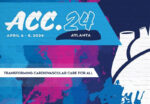Mitral annulus calcification (MAC) affects between 8% and 23% of the population. It is more common in women and patients with renal insufficiency. This phenomenon is characterized by an increase in valvular annulus fibrosis, which can extend and affect the leaflets. The presence of MAC is associated with valve regurgitation or stenosis, increasing mortality and<a href="https://solaci.org/en/2024/07/18/myocardial-damage-in-mac/" title="Read more" >...</a>
Edge-to-Edge Repair for Right Ventricular Function Deterioration
Tricuspid regurgitation (TR) has been associated with worse survival and hospitalization for cardiac failure (CF). The current guidelines recommend surgery as treatment, despite its 8 – 15% 30-day mortality rate. And there is no mention of a transcatheter intervention, especially for patients with severe TR and right ventricular deterioration. Several percutaneous intervention devices have recently<a href="https://solaci.org/en/2024/07/12/edge-to-edge-repair-for-right-ventricular-function-deterioration/" title="Read more" >...</a>
Evolution of Cardiac Damage in MitraClip
Degenerative mitral valve regurgitation affects the mitral apparatus and is related to severe insufficiency. At present, surgery is the treatment of choice for patients at low risk. Oftentimes, this disease affects the elderly and/or those at high surgical risk, edge-to-edge repair being an excellent treatment alternative. We all know that the different stages of ventricular<a href="https://solaci.org/en/2024/07/09/evolution-of-cardiac-damage-in-mitraclip/" title="Read more" >...</a>
Predictors of DCB Failure in De Novo Lesions
Percutaneous coronary intervention (PCI) with drug coated balloons (DCB) is a viable alternative, especially in patients at high risk of bleeding, side-branch lesions in coronary bifurcation, or in small coronary segments. De novo heart disease treated with DCB has been shown non-inferior to conventional DES stenting, according to the PICCOLETO-II trial. However, these interventions are<a href="https://solaci.org/en/2024/07/08/predictors-of-dcb-failure-in-de-novo-lesions-2/" title="Read more" >...</a>
Prehospital Crushed vs. Integral Prasugrel in STEMI Patients with Large Myocardial Area at Risk
Timely percutaneous intervention of STEMI patients effectively reduces MI size and mortality, which currently makes it the first line of treatment. A fundamental aspect is activation and platelet aggregation, which is why, in addition to creating networks to optimize STEMI treatment, prehospital drug treatments have been implemented. The COMPARECrush looked at whether early and powerful<a href="https://solaci.org/en/2024/07/08/prehospital-crushed-vs-integral-prasugrel-in-stemi-patients-with-large-myocardial-area-at-risk/" title="Read more" >...</a>
High Gradients After Valve-in-Valve
One of the limitations of aortic bioprostheses is their durability. When these devices fail, percutaneous valve implantation is a valid strategy. However, it has been shown that there may be high gradients involved. This gradient increase has been associated with worse outcomes and higher mortality rates, as observed in the PARTNER 2 study at 12 months.<a href="https://solaci.org/en/2024/06/18/high-gradients-after-valve-in-valve/" title="Read more" >...</a>
EuroPCR 2024 | Complete revascularization affects clinical outcomes? REVIVED.BCIS2 Insights
Complete revascularization has shown in several studies and meta-analysis a benefit in mortality vs. incomplete revascularization. The REVIVED-BCIS looked at whether there were differences in mortality and hospitalization for cardiac failure in patients with ventricular function deterioration and viability when comparing coronary angioplasty(PCI) against optimal medical treatment. This study showed that PCI was not associated<a href="https://solaci.org/en/2024/05/17/europcr-2024-complete-revascularization-affects-clinical-outcomes-revived-bcis2-insights/" title="Read more" >...</a>
Aortic Stenosis Progression Evolution
Aortic stenosis is an increasingly common valvulopathy because people are living longer now. A present, the main treatment consists of surgical (SAVR) or transcatheter aortic valve replacement. (TAVR). One of the main challenges of this disease is its progression. The European guidelines recommend Doppler echocardiograms every 2 to 3 years for mild cases, mildly calcified,<a href="https://solaci.org/en/2024/05/15/aortic-stenosis-progression-evolution/" title="Read more" >...</a>
TAVR in Bicuspid Valves
Bicuspid aortic valve (BAV) disease affects 1%-2% of the population and manifests with severe aortic stenosis in the middle-aged. It characterizes for a very different anatomy with more calcification than the tricuspid aortic valve. At present, surgical aortic valve replacement (SAVR) is the first treatment indication. TAVR in this scenario has shown, in different studies,<a href="https://solaci.org/en/2024/05/07/tavr-in-bicuspid-valves/" title="Read more" >...</a>
ACC 2024 | RELIEVE-HF
Heart failure is characterized by increased left atrial filling pressure and venous congestion which intensify with exercise and volume burden, and makes conventional medical management hard. In this context, interatrial shunting might offer a self-regulating mechanism, as shown by the Ventura IAS study. The aim of this study was to assess the safety and efficacy<a href="https://solaci.org/en/2024/04/10/acc-2024-relieve-hf/" title="Read more" >...</a>









